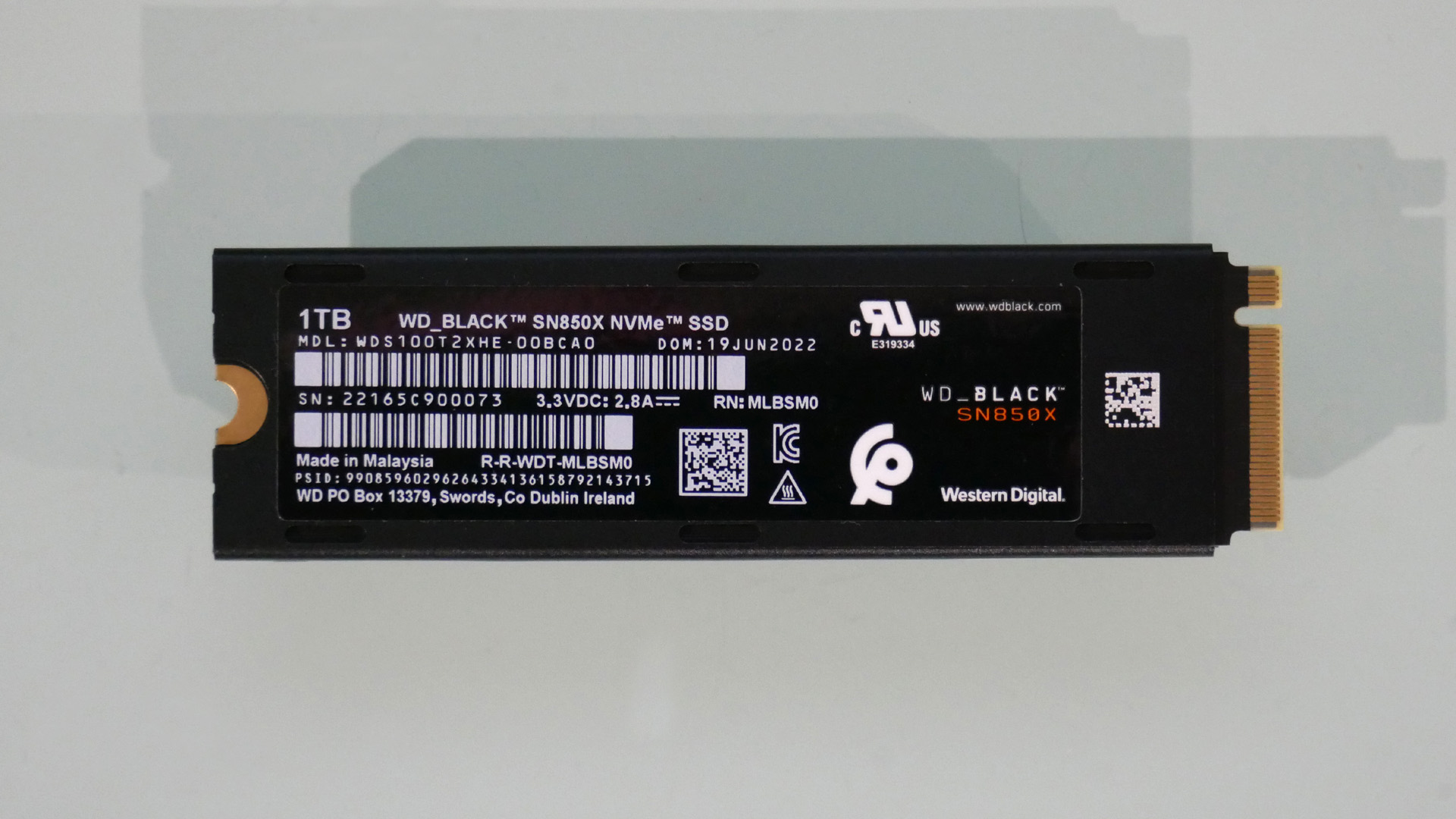GamesRadar+ Verdict
WD’s premium M.2 SSD gets some added ‘X’ factor, improving thermals and making it an ideal M.2 drive ideal for PS5 use.
Pros
- +
Much improved operating temps
- +
Improved suitability for PS5
- +
Still a great all-rounder
Cons
- -
4K performance is little improved
- -
Heat sink may not be relevant for PC
Why you can trust GamesRadar+
With a brave new era of PCIe Gen 5 SSDs for gaming just around the corner, for the PC at least, the new WD Black SN850X 1TB represents the last gasp for high-end Gen 4 SSDs. Unsurprisingly, then, this isn’t a radical new design. Instead, it’s a revision of the existing WD Black SN850 non-X, an SSD that remains one of our favourite M.2 drives for PC use, and as a PS5 SSD.
The original SN850 combines a competitive price with great all-around specifications and performance, not to mention the reassurance of the big, well-regarded storage brand like WD. If it had a weak point, it was operating temperature; the SN850 runs a little hot. Handily, this new SN850X model addresses that head-on. First, it has WD’s full-length heat spreader. But WD also says the drive has a new thermal management profile to reduce performance throttling under heavy load.
That could be a particular benefit for the relatively tight and hot confines of the PS5's SSD bay, for sure. The original SN850 (without heatsink) was always fine in a well-ventilated PC, but wouldn’t have been our recommendation for PS5 storage upgrade. The new SN850X promises to fix that. It also brings a number of additional tweaks including a revised controller chip and upgraded NAND flash memory. Could this be the ultimate drive to see out the PCIe Gen 4 generation? Time to find out.
Design & Features
As reviewed, the new WD Black SN850X 1TB is a standard format M.2 drive but sports a full-body heat spreader to help keep operating temps down. The design is purpose-built for Sony’s PS5 consoles.
It is, of course, compatible with pretty much any gaming PC with an M.2 slot. That said, if your motherboard comes with its own M.2 cooler or heat spreader, it may make more sense to buy a bare M.2 drive than cough up for a model with a factory heat spreader like the SN850X.
Anyway, as before this is a quad-lane PCIe Gen 4 M.2 drive. It’s running an updated version of WD’s in-house controller chip, though there are few details on exactly what changes have been made or how the controller has been improved beyond the aforementioned revised thermal profile with a view to reducing operating temps.

New for the SN850X are upgraded 112-layer TLC NAND flash memory chips, replacing the 96-layer chips from the SN850 non-X. Again, specifics on the new chips are scarce. But with each generation of TLC NAND, which is the dominant flash memory type in current performance drives, throughput and latency tend to improve.
Capacities are also up for the new ‘X’ model. Where the old SN850 kicked off at 512GB and topped out at 2TB, the new SN850X starts at 1TB and extends all the way to a new 4TB model. But one thing that hasn’t changed is write endurance, with this 1TB model offering 600TB of writes. That’s similar to several other drives of the same capacity in this segment, including the Samsung 980 PRO.
Finally in the features column, the WD Black SN850X 1TB comes with the latest 2.0 iteration WD’s Game Mode drive management software. For the PC, it’s said to improve game loading times courtesy of a "read look-ahead" algorithm that predicts and pre-caches game data. Exactly how much difference that kind of feature makes in the real world is difficult if not impossible to verify. But it probably doesn’t hurt.
Performance
In terms of claimed performance, WD says the new Black SN850X 1TB is slightly faster across the board compared with its immediate predecessor, the WD BLACK SN850. Sequential write speeds are up a notch from 7,000MB/s to 7,300MB/s, while reads leap up from 5,300MB/s to 6,300MB/s. As for IOPS performance, the old 1TB drive was rated at 1M for reads and 720K for writes. This new drive improves to 1.1M and 800K respectively.
In testing, sequential reads are indeed just over 7,300MB/s with writes likewise in excess of WD’s 6,300MB/s figures. The 4K random access numbers are, if anything, a little disappointing, with lower results than the older drive. But they are close enough to reflect changes in testing platform in the intervening period, rather than an issue with the new drive. Just don’t go thinking the new SN850X is going to set new standards for 4K performance. It doesn’t.
There’s better news when it comes to thermals. We measured a peak of 77 degrees C with the old SN850, which is rather toasty. But this drive reduces that to a much more manageable 58 degrees. Nice job and definitely suitable for console applications. For the record, the drive’s high-performance SLC cache provisioning hasn’t changed. With an empty drive, you get roughly 300GB of SLC cache writes and thus sustained peak throughput before the underlying performance of the TLC chips is exposed. That should be plenty for most purposes.

Overall - should you buy the WD BLACK SN850X?
Even on paper the new WD Black SN850X 1TB is not a major advance on the existing non-X SN850 drive. In many ways, that was inevitable; the SN850 was already bumping up against the limitations of the PCIe Gen 4 interface by some measures.
That said, a couple of issues are worth noting, for better and worse. 4K performance is little, if at all, improved with this new drive, which is a pity. But thermal management and sustained performance, however, have definitely been improved thanks to the revisions. On the PC, the fact that the old SN850 ran hot wasn’t that big a deal. But the reduced temps of the SN850X are a genuine benefit for PS5.
All of this means it’s now easy to recommend this drive for almost any application. It’s a great all-rounder. Our only reservation would involve paying the slight premium for this particular model and its full heat spreader. Some PC motherboards come with very good M.2 drive cooling of their own, in which place there’s little point in paying twice.
How we tested the WD BLACK SN850X
We began testing the SN850X by entirely filling it with data. This reveals the size of the SLC cache, can uncover any thermal throttling, and also indicates the quality of the drive’s garbage cleaning algorithms. We then put it through its paces on PCMark10 to gain an overall assessment of performance, plus an insight into latency. Then we finish with some sequential and 4K synthetics, during which we also take note of peak operating temps. Combin all of this, and the SN850X has been put through some solid testing in order to successfully attain an accurate overall picture of its performance.
You can read more on how we test SSDs and hard drives at GamesRadar+ in our dedicated article, or for a more holistic overview of our approach to tech, check out our Hardware Policy.
And if your search is more for something externally-shaped then check out our guides to the best external hard drives, best PS5 external hard drives, and best Xbox Series X external hard drives to cover your bases.
A serious dissertation on the finer points of input lag and overshoot followed by a forensic examination of AI-accelerated temporal upscaling. Such is a routine day in the working life of long-time tech wordsmith, Jeremy Laird. Along with GamesRadar, Jeremy’s 15-year back catalogue includes a host of tech and gaming outlets, including TechRadar and PC Gamer, not to mention contributions to mainstream media from the Independent to the Evening Standard. Complimenting Jeremy’s debilitating addiction to all kinds of digital hardware, he is also afflicted by an obsession with and a significant occupational sideline in cars and automotive technology.





